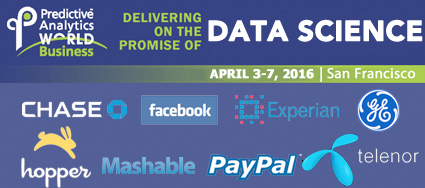Traditional business intelligence (and data mining) software does a very good job of showing you where you’ve been. By contrast, predictive analytics uses data patterns to make forward-looking predictions that guide you to where you should go next. This is a whole new world for small businesses seeking enterprise application opportunities, as well social media trend challenges.
According to Eric Siegel in his newly updated book “Predictive Analytics,” it’s the power to predict who will click, buy, lie, or die. He calls his book a primer, but his real-life examples illustrate well how predictive analytics unleashes the power of data, and how “big data” embodies an extraordinary wealth of experience from which to learn.

USE CODE PATIMES16 for 15% off Predictive Analytics World Conference pass.Eric provides many examples of potential and real application areas that are ripe for predictive analytics, but my view is that smart entrepreneurs can extrapolate these to hundreds more, just waiting to be tapped. Here are ten examples to get your creative juices flowing:
- Targeted direct marketing. The challenge is to increase response rates and propagate a single view of the customer, by integrating customer data from multiple Web and social media interactions. Then companies can determine promotional effectiveness by narrowly defined customer segments, by location, or by delivery channel.
- Predictive advertisement targeting. Online, everyone wants to know which ad each customer is most likely to click. Then they can display the best ad, based on the likelihood of a click, as well as the bounty paid by its sponsor. Everyone wins, since consumers hate being presented with ads that are irrelevant to them.
- Fraud detection. We all want to know which transactions or applications for credit, benefits, reimbursements, refunds, and so on, are fraudulent. On the other side of the table, businesses need to minimize false insurance claims, inaccurate credit applications, and false identities.
- Investment risk management. Whether you are contemplating an investment in your favorite startup, or a little-known stock on a public exchange, there is “big data” out there that can’t possibly be evaluated by you without predictive analytics. Companies need the same service on partner and acquisition candidates, even vendors.
- Customer retention with churn modeling. Every business wants to predict which customers are about to leave, and for what reasons, so they can target their retention efforts. New one-time customers may be incented to return. Without predictive targeting, a retention campaign may cost more than it gains.
- Movie recommendations. Movies are selected, or recommended to customers, based on past reviews, related interests, or analysis of Twitter comments. On the movie production side, it’s time to start doing analyses on movie scripts, based on reaction to similar movies, to predict box office revenue and cities to hit.
- Education – guided studying for targeted learning. Every quiz show aficionado would like some guidance on which question areas need more study, and every student needs help on how to spend his limited study hours more effectively. Schools need the same analysis to provide more effective teaching media and techniques.
- Political campaigning with voter persuasion modeling. I’m sure every campaign would love to know which voters will be positively persuaded by specific contacts, such as a phone call, door knock, flier, or TV ad. The rest of us would rather not be annoyed by the multiple contacts of the wrong type.
CONTINUE READING: Access the complete article in Huffingtonpost, where it was originally published.
